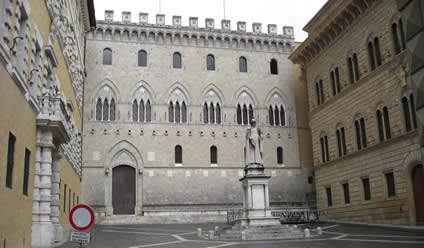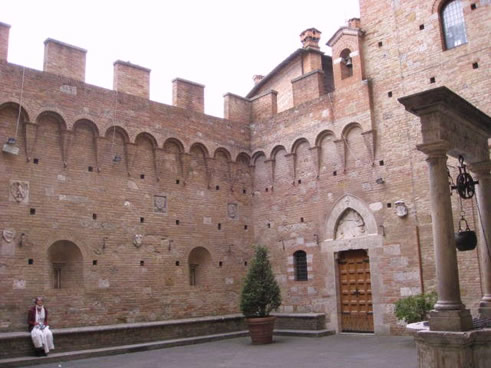| |
Palazzi in Siena
|
Siena's streets are lined with mediaeval and Renaissance palazzi built by the important families of the city - Chigi, Piccolomini, Tolomei, Salimbeni etc. Some had several palaces belonging to different branches of the family. Each palazzo are named after the family who lived there and some have double names to reflect the passing of a palazzo to a new family - as the fortunes of the familues rose and fell or marital alliances were made, palazzi were bought and sold. Unfortunately, the exteriors of the palazzi are difficult to see properly, because of Siena's narrow streets. Most are not open to the public, but some are museums and some - especially those in public ownership - are occasionally open for special exhibitions which gives one a chance to see the often lavish interiors. This guide describes only a fraction of the palazzi.
Some of the grandest are on the Campo. Others include:
- Palazzo Salimbeni, on the Piazza Salimbeni off the Banchi di Sopra. Its white marble Gothic façade is one of the most reproduced images of Siena, but in fact much of it is the result of some heavy remodelling in the 19th century. It was the ancient home of the Salimbeni family and is now the headquarters of Siena’s ancient bank, the Monte dei Paschi di Siena. It was established in the 15th century, is the oldest continuously operating bank in the world and is still a dominant force in Sienese affairs, contributing major subsidies to charitable and artistic activities (although it has had to make major cuts in its activities following the fimancial crisis, when it had to be rescued by the Italian government). It was originally established as a state-run “Monte di Pietà” – a medieval credit institution for lending to the poor. The word “Paschi” was added in the 16th century and comes from an old word for “pasture lands”, as part of the finance for the bank was provided by bonds based on the revenues of pasture lands in the Maremma, south of Siena. The Bank (which has quite a good art collection) does organised tours of the building, but they are not easy to arrange).

Palazzo Salimbeni
- Palazzo Tolomei, further down the Banchi di Sopra on the other side facing Piazza Tolomei. One of the oldest buildings in Siena, it was built in the mid-1200s and is a good example of a gothic private residence. The Tolomei were rivals of the Salimbeni, and it is perhaps fitting the Palazzo Tolomei now houses the Sienese headquarters of the Florentine bank that is the Monte dei Paschi’s main rival.
Palazzo Tolomei
- Palazzo delle Papesse at 126 via di Città. This massive palazzo was built in 1485 for the sister of the Piccolomini pope Pius II, and designed by the Florentine Bernardo Rossellini, the architect of Pienza. It is very much in the Florentine renaissance style, reminiscent of the Palazzo Pitti with its great rusticated blocks of stone. The palazzo was opened in the late 1990s as a gallery of contemporary art, but has now closed again. The collections formerly in it have been moved to the museum complex at Santa Maria della Scala opposite the Duomo.
- Palazzo Chigi-Saracini at 82 via di Città, a gothic-style structure with a lovely courtyard. The nucleus of the building dates back to the 1100s when it the castle of the then powerful Marescotti family. Before the Palazzo Pubblico was built, it briefly housed part of the Sienese government. Only the tower now remains of that early building. The structure changed hands between various dominant Sienese families over the centuries and was enlarged and modernised by them to create the present building. The next door buildings were incorporated into the structure in the 1300s by the Marescotti. In the 1500s when the palazzo was acquired by the Piccolomini-Mandoli family, the renaissance-style inner courtyard was created. In the 18th century the palace was acquired by the Saracini family who lengthened and largely rebuilt the front of the building in 13th century style to create the curving façade of today.
From the Saracini family the palazzo passed by inheritance to a branch of the huge Chigi family, who added Saracini to their name. A 19th century Chigi-Saracini filled the palazzo with works of art and redid much of the interior in renaissance style. The early 20th century owner, Guido Chigi-Saracini, whose passion was music, turned the ballroom into a magnificent concert hall decorated in the baroque style and filled the Palazzo with music and musical mementos. In 1932, with the help of the Monte dei Pasqui bank, he founded a musical academy in the palazzo, the Accademia Musicale Chigiana, which quickly attracted many world famous musicans. The Academy is still operating today as a summer music school and there is a good series of classical concerts during the summer months.
There are guided tours of the palazzo (in Italian and English), which last about an hour. Many of the rooms are closed for music lessons during the summer season, so a visit is more rewarding between September and June. Much of the art consists of huge canvases by Siena’s less distinguished 17th century painters, but there is a good Beccafumi of the mystic marriage of St Catherine in the “piano room”, some interesting pieces of furniture and ancient musical instruments and of course the magnificent if somewhat bogus décor of the rooms.

Courtyard of the Palazzo Chigi-Saracini
- Palazzo Chigi-Piccolomini
Also known as the Palazzo Chigi alla Postierla (after the neighbouring piazza) or Palazzo Piccolomini-Adami (after a later owner). It is on the corner of via del Capitano (which runs between via di Città and piazza del Duomo), at the far end from the Duomo. It is now state-owned and open only for special events, but well worth a look inside if you get a chance, on account of its two magnificently frescoed rooms.
The palazzo was built by Scipione Chigi in the second half of the 16th century and remained in the Chigi family until 1785 (the Chigi were one of Siena’s most important families, deriving their wealth from banking). Outside, it is of massive stone construction, probably designed by Bartolommeo Neroni (also known as Il Riccio), one of those polymathic painter-sculptor-architects which Siena seems rather good at producing. Inside it has two salons, one above the other (apparently so that Chigi could give each of his two sons an equally splendid apartment), with colourful and delicate late Renaissance frescoes and plasterwork.
The first floor salon is frescoed on both walls and ceiling with scenes from the Old Testament. Unfortunately, they have not survived well, but the room nevertheless makes a colourful and attractive impression. The frescoes on either side of the entrance are among the best preserved, representing David with his harp on the left and on the right the superman hero Samson carrying the donkey jawbone with which he is supposed to have massacred an entire Philistine Army. The frescoes were painted by the Flemish artist Bernard van Rontwijk in 1573.
Between the frescoes are typical mannerist “grotesque” (grotto-esque) style decorations with fantastical plants and creatures, inspired by the decoration of the Golden House of Nero in Rome which had only recently been rediscovered after centuries of burial. In the centre of the ceiling there is a magnificent plaster panel by Marcello Sparti of Urbino, a mannerist stuccoist who worked all over Italy, portraying the Old Testament heroine Jael about to slay the Canaanite general Sisera by driving a tent-peg into his temple with a mallet – a beautiful if macabre work.
The frescoes and paintings in the second floor salon represent scenes from the life of two famous Roman military commanders: Scipio the African who beat Hannibal in the Punic Wars and Furius Camillus from the early days of Rome who won a famous battle over the Etruscans. Both were known for their magnanimous acts in victory and both were later reviled by their governments and ended their lives in exile. This floor was for his elder son and the choice of paintings must have been intended to convey a message.
The oil paintings along the walls of the life of Scipio the African (clad in a bright turquoise tunic) are by a Dutch artist, Dirck de Quade van Ravesteyn (1565-1620). The series begins at the far right corner of the room:
- The young Scipio saving his father who had been wounded during Hannibal’s crossing of the Alps (218 BC), by "charging the encircling force alone with reckless daring", according to the Greek historian Polybius.
- The 19-year old Scipio, a junior soldier, tries to rally the Roman troops after their defeat at Cannae (216 BC), and confronts senior officers who wanted to flee into exile.
- “The restraint of Scipio”: after the conquest of the Carthaginian city of New Carthage (Cartagena in Spain) in 209 BC, Scipio shows generosity towards the population. When his troops offered him a beautiful female captive and after discovering that she was promised in marriage to a local chieftain, he gives her the money that her father had offered as a ransom for her freedom.
- Meeting of Hannibal and Scipio before the battle of Zama near Carthage (202 BC). Hannibal was trying (unsuccessfully) to negotiate a peace deal. The female figure in tears represents the sorrowful city of Carthage.
- Scipio burns the Carthaginian fleet. Having beaten the Carthaginians at Zama, Scipio did not as expected by many raze Carthage to the ground, but he did require the surrender of the Carthaginian fleet, which was set alight.
- Scipio enters Rome in triumph.
- Scipio in exile at Liternum on the Italian coast, receiving a visit from the pirates who worked that coast, who had come to honour him with gifts, showing that they appreciated his worth more than the Romans who had driven him into exile.
Higher up and on the ceiling are frescoes of episodes of the life of Furius Camillus painted by Bernard van Rontwyk in 1573:
- The taking of the city of Veii. In 406, the Romans had declared war on this Etruscan city and Camillus was the Roman leader who conquered it.
- Camillus enters Rome in triumph after the victory in a chariot drawn by four white horses – a gesture that turned many Romans against him, as such horses were sacred to the gods.
- An attempted betrayal by a teacher from Falerii, an ally of Veii to which Camillus had laid siege. The teacher came to the Roman camp with his pupils, sons of eminent citizens, and offered them as hostage.
- Camillus punishes the teacher from Falerii. Disgusted by the teacher’s betrayal of his city, Camillus sends the teacher and his pupils back to the town, whose people are so impressed by his noble attitude that they decide to make peace, confident of Camillus’ magnanimity.
- Camillus and Brennus. After the sack of Rome by the Gauls headed by Brennus, the Romans attempted to buy the liberation of the city for 1,000 pounds of gold. There was a dispute, however, over the weights used to measure the gold and Brennus contemptuously threw his sword onto the scales, crying “vae victis” – woe to the conquered. Camillus, according to legend, then managed to muster an army from his exile and succeeded in retaking Rome, crying “non auro sed ferro recuperanda est patria” – the nation is to be recovered not by gold, but by iron.
A collection of 17th century Sienese paintings, which seem to be cast-offs from the Pinacoteca, hangs in other rooms of the Palazzo. There is also a charming little private chapel.
|
|